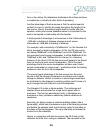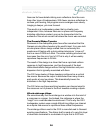
27
absolute fidelity
enclosure all work together in unison to produce bass output that
descends evenly to below your hearing limits.
Servo-controlled Bass Amplifier
One problem, however, of metal cones, is that of greater mass –
even ones as light as the ones used by Genesis. To over come
this, we had to build an amplification system of great power, and
high damping factor. The servo-system also places extraordinary
demands on the amplifier because the system uses enormous
amounts of current to make the woofer follow the input signal. This
means that the amplifier used must efficiently deliver extraordinarily
large amounts of clean power into low impedances.
The servo-controlled bass amplifier was designed as a holistic
system of woofers, integrated connecting cables, amplifiers, servo-
control and remote controlled crossover circuitry. Two separate
two-channel amplifier modules are used for the left and right woofer
towers.
Specially designed and tuned Dynamic Power Delivery System
(DPDS) power supplies are used – one for two channels – to
deliver balanced dynamics which are critical to bass accuracy. This
improves the power factor of the power supply in delivering the
bass frequencies, resulting in “floorshakingly musical” bass to
power the servo woofers.
A further advantage to separating the amplifier modules of the left
and right woofer towers is that if you are lucky enough to have
multiple 20amp circuits in your listening room, you can power each
woofer tower from a separate circuit. This allows for even better
transient bass dynamics. The Maximum Dynamic Headroom
Reservoir (from the Genesis Reference Amplifier) is also available
as an upgrade to Servo-Controlled Bass Amplifier, which will give
even faster bass transients, and better macro- and micro-
dynamics.
One side benefit of this powered woofer system is that almost any
sized amplifier can be used to drive the mid/tweeter section of the
Genesis 2.2. No longer must one choose between having an
amplifier with enough power to drive the woofers, and a smaller
amplifier having better spatial and tonal characters. Nevertheless,
we do recommend no less than 100 watts as a minimum for the
midrange/tweeter sections.


















